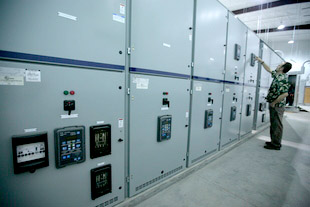Jul 30 2009
Electrical engineering researchers at the University of Arkansas and the University of South Carolina were informed this week that they will receive federal economic stimulus funds via the National Science Foundation to continue and strengthen their efforts to modernize the national power grid. The award will establish an NSF center of excellence, known as an Industry/University Cooperative Research Center.
 Federal economic stimulus funds via the National Science Foundation will enable University of Arkansas researchers to strengthen their work at modernizing the national power grid
Federal economic stimulus funds via the National Science Foundation will enable University of Arkansas researchers to strengthen their work at modernizing the national power grid
The new center will focus on grid-connected, advanced-power electronic systems and will be operated jointly by researchers at both universities. It reinforces a major research thrust – grid-connected power electronics – of the university’s existing National Center for Reliable Electric Power Transmission.
“These funds will help us develop the knowledge, tools, hardware, software and personnel to flood the 21st century power grid with power electronics,” said Alan Mantooth, professor of electrical engineering and executive director of both the new center and the existing NCREPT. “The nature of this grant will enable us to expand NCREPT’s work with utility companies, defense contractors, equipment manufacturers, component suppliers and others to bring to market the technologies that will be needed to realize a robust and more reliable power grid.”
The award, funded under the American Recovery and Reinvestment Act of 2009, becomes effective Sept. 1 and lasts for five years. It is renewable for up to another five years. Each year of the grant period, the National Science Foundation will provide $113,000 for administrative costs to the University of Arkansas as lead institution and $63,000 to the University of South Carolina. In addition, as part of the industry/university cooperative, large companies – the utility companies and equipment manufacturers Mantooth mentioned – will contribute $40,000 per year to be members of the center. Small companies, as defined by the federal Small Business Administration, will contribute $5,000 annually. So far the center has recruited 12 private companies and is seeking more, Mantooth said.
The researchers work with purely electronic – referred to as “solid-state” – systems, which they are designing to replace or augment the grid’s existing electromechanical switchgear. The latter sometimes do not function as quickly as needed and thus lead to unreliable service. Made of silicon-carbide, a durable and fast semiconducting material, new solid-state systems will help manufacturers produce power electronic hardware that can react as much as 200 times faster than the electromechanical devices currently used in the power grid.
Mantooth said the combination of academic research and industry insight, made possible by this grant, will accelerate commercialization of solid-state systems. The researchers will focus on design, development, evaluation, control and standardization of grid-connected power-electronic equipment. Attention will also be given to intelligent coordination of the emerging, digitally controlled electric power grid.
The overall goal of the center is to pursue projects that enhance grid reliability. The center will also train students and practicing engineers to develop and manage the next generation of power systems. Producing more students in this field is important to both Arkansas and the nation, Mantooth said. The energy and power industry estimates that more than 50 percent of the engineers will retire in the next five to 10 years. Young people are being encouraged to strongly consider a career in electrical engineering to meet this demand.
“To put this in perspective, if all the of country’s electrical engineering programs put all of their students into this field, it wouldn’t be enough,” Mantooth said. “So our graduates are seeing wonderful employment opportunities at the bachelor’s, master’s and Ph.D. levels.”
The grant will help researchers make full use of NCREPT’s unique test facility, a 7,000-square-foot building at the Arkansas Research and Technology Park in south Fayetteville. The facility, which is capable of testing power systems up to 6 megawatts, consists of several transformers, many circuit breakers and regeneration drives that are connected in a highly reconfigurable and programmable manner to enable many types of application scenarios, including distributed generation (wind, solar, etc.) and protection devices.
In addition to Mantooth, other University of Arkansas researchers involved in the project include Simon Ang, Juan Balda and Roy McCann, professors of electrical engineering; T. A. Walton, the managing director of NCREPT; Yongfeng Feng and Brian Rowden, research assistant professors; and approximately 40 graduate and undergraduate students in electrical engineering.
Mantooth is the Twenty-First Century Chair in Mixed-Signal Integrated Circuit Design and Computer-Aided Design in the College of Engineering.